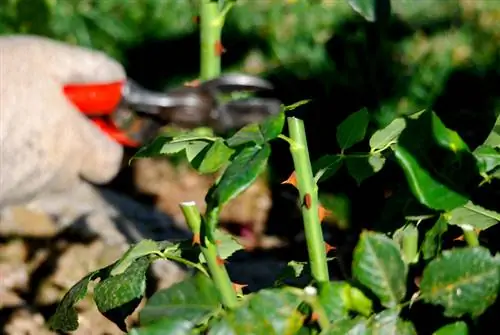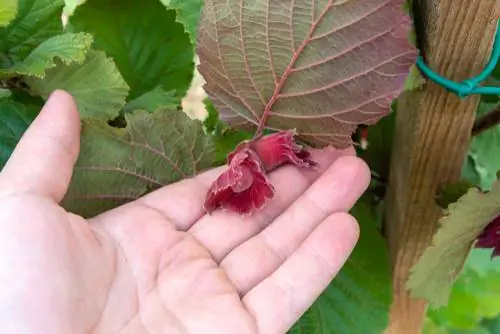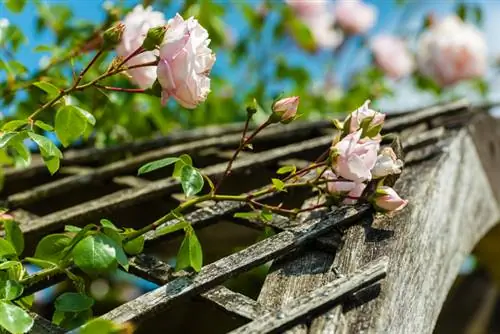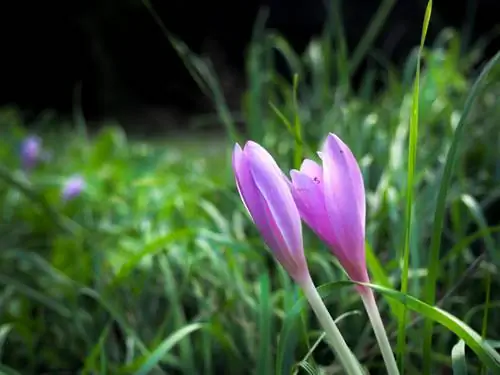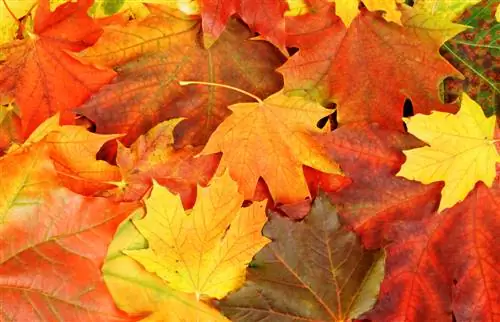- Author admin [email protected].
- Public 2023-12-16 16:46.
- Last modified 2025-06-01 06:02.
Noble roses in autumn are only remotely reminiscent of the majestic floral beauties of summer. Although the actual pruning care has been completed, rose gardeners are now reaching for the scissors again. Read this tutorial to find out when and how autumn rose pruning makes sense.
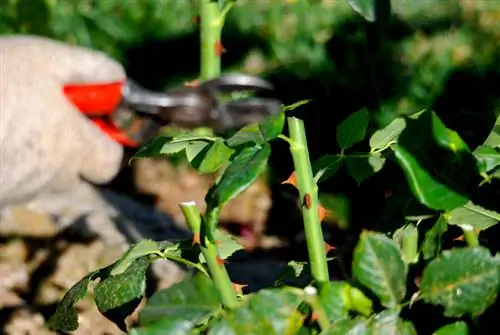
When and how should you cut roses in autumn?
In autumn, roses should only be trimmed carefully by removing withered flowers above the next pair of leaves or buds and cutting back excessively long, disruptive shoots by a maximum of a third. In addition, dead leaves should be removed from the branches.
Not compulsory - but advantageous
Pruning roses in autumn was frowned upon for a long time. Reason for the taboo: The cut causes fresh shoots that do not mature before winter. A few degrees below zero are enough for the soft shoot tips to freeze back into the wood and ruin hopes for the next flowering season.
According to modern findings, slight frostbite on unwoody shoot ends is not a problem. On the contrary, uncut rose branches slow down bitterly cold wind and direct it to the lower areas, so that locally the temperatures drop drastically and cause buds to freeze. If overly long rose shoots gesture in all directions, it is difficult to install reliable winter protection. Last but not least, order-loving gardeners struggle with the unkempt appearance of uncut rose bushes that last for months.
Since practical experience has supported modern knowledge, there has been a rethinking of how to care for roses. Today, rose gardeners decide - in addition to spring and summer pruning - to prune again in autumn.
Cutting bed and noble roses
Over the course of the summer, bed, bush and noble roses transform into a dense network of thorny branches. When the flowering period is finally over in autumn and the leaves come in, withered flower heads and limp leaves disfigure the rose bushes. There is no thought of getting through to pile up the plant base for winter protection. These are several reasons for an autumn pruning. How to do it right:
- Sharpen rose scissors, clean and disinfect with alcohol
- Cut off wilted flowers above the next pair of leaves or buds
- Cut back excessively long, disruptive shoots by a maximum of a third
- Pick all the dead leaves off the branches
When pruning your roses in the fall, you can easily approach the pruning process in a casual manner. In exceptional cases, a perfect cutting technique on buds is not necessary. Precision is only required again during the main cut in spring.
Cut budding branches
If roses demonstrate their ability to bloom with buds in autumn, the shoots are far too good for the organic waste bin. Cut off budding or flowering branches at the base. The royal flowers will continue to unfold in the vase for some time. Although tightly closed buds do not open completely after an abrupt change from the cool garden to the warm room. The shoots guarantee decorative accents with autumnal flair.
Excursus
Continuously remove wild shoots
Wild shoots strive to overgrow the noble rose until the last warm ray of sunshine. From early spring to the beginning of winter, the wild rootstock vehemently sends out strong shoots in order to gain the upper hand in the battle for light and nutrients. Keep an eye on your bed, shrub and noble roses throughout the season to remove wildlings as quickly as possible. The unwanted shoots can be easily identified by the arrangement of their leaflets. With up to fifteen individual leaves, blind shoots differ significantly from cultivated roses, whose elegant pinnate leaves consist of an average of five individual leaves.
Climbing roses - autumn pruning instructions
Their exposed position on the trellis makes autumnal pruning useful for climbing roses. If you don't want to be annoyed by wilted flowers and brown leaves all winter long, get out the rose scissors again in autumn. Order-loving rose gardeners don't miss this opportunity to rearrange the vines. How to do it professionally:
- Remove awkward rose vines from the climbing frame and place them on the ground
- Leave well-positioned shoots on the trellis
- Cleaning up wilted flowers
- Short shoots that protrude above the trellis by a third
- Important: ideally do not cut this year's long shoots
- Remove dead leaves completely
After the autumn clean-up, tie the vines back on. If there is a lack of space on the climbing frame, start with this year's unbranched long shoots. Your climbing rose will have the most beautiful flowers on these tendrils next year. If a tendril has to go, it should be an older, massively branched specimen.
Cut and pack standard roses
On standard roses, amoderate care pruning in autumn paves the way for perfect winter protection. Here the sensitive grafting area is located below the crown and is therefore particularly susceptible to severe frost. Without a warming hood, a rose stem is defenseless against the rigors of winter. The cover is easier to install if you shorten the branches slightly beforehand. How to do it right:
- rose crown all aroundone thirdcut back
- Pluck out accessible leaves
- Wrap the crown in a breathable winter fleece
- Tie the hood together below the grafting point on the trunk
In harsh winter regions, it is also advisable to place a bucket on wood and wrap it with bubble wrap or jute. Cover the substrate with autumn leaves (no rose petals), straw or bark mulch.
Tip
Under no circumstances should roses be fertilized in autumn. In the worst case, the nutrients cause a rose bush to sprout again. Soft shoots have no resistance to winter frost, they freeze back and damage the entire plant. If you want to arm your roses with potassium for the cold season in autumn, apply the fertilizer by mid to late August at the latest.
Always dispose of clippings
Plant hygiene is very important when it comes to caring for roses. Hardly any modern noble rose is immune to disease. It is primarily the pretty pinnate leaves on which pathogens settle. Varieties with the label 'ADR Rose' usually defend themselves against infection on their own. Cunning fungal spores can still overwinter in the rose bed with the clippings or autumn leaves.
This means that the pathogens will find their way onto the leaves even faster next year. In this way, an infestation that was barely noticeable in the previous year can take on serious proportions. Please always dispose of clippings and fallen rose leaves in the trash can. Pathogenic pathogens are not reliably killed in the compost heap.
Do not cut wild roses
Wild roses decorate the winter garden with colorful rose hips. For this reason alone, the natural beauties in autumn are not a case for rose scissors. Environmentally conscious rose gardeners avoid pruning because the round fruits are a valuable source of food for wintering birds.
Background
Postpone pruning until March
Planting pruning plays a key role among the types of pruning for roses. You can plant container roses all year round as long as it doesn't freeze. For bare-root roses, the planting window is open from October to March. If you decide on an autumn planting date, theplant pruning will not take place until the following spring The forsythia blossom provides a reliable indication of the best date. Cut all shoots back to 3 to 5 eyes. The cut causes a sap to accumulate, whereupon the young rose sprouts vigorously and branches.
Tips for the perfect cutting tool
Autumn rose pruning focuses on withered flower heads and the upper third of the shoot. With sharp rose scissors you are ideally equipped for moderate care pruning. Scissors with a bypass mechanism are recommended because two sharp cutting edges run against each other and create smooth cuts. Especially under the influence of cold temperatures, it is important that cut surfaces close in good time before the first frost.
Thorn-proof gloves with long cuffs are essential. It is primarily the long cuffs that protect your arms from painful injuries when you pluck dead leaves from inside the bush.
Frequently asked questions
If I plant the ground cover rose 'Snow Queen', do I have to prune it twice a year?
Ground cover roses can be allowed to grow freely. Annual pruning in March or April is beneficial for bushy growth with lush branching, especially during the first three to four years. Pruning twice a year would be too much, as the creeping roses only grow slowly. In contrast to bedding, shrub and noble roses, ground cover roses are not cut in autumn.
My noble roses still have buds in September. What care measures should I take? Can I just leave the shoots as they are and cut them in spring?
You will prepare your roses perfectly for winter if you pile the plants generously. A protective cover is not necessary as long as you last fertilized in August. If you fertilized in September, be sure to protect the soft shoots that then sprout with an air-permeable fleece. If individual branches get in the way when attaching a hood, you can safely cut them off. Branches with buds or recent flowers are ideal for a vase cut. Don't do the main pruning until spring, when the forsythia are blooming.
When we move, we would like to take the most beautiful rose bushes with us. When and how should we ideally transplant the roses?
The best time to relocate your roses is during the leafless period in autumn or early spring. Please make sure that there were no rose plants in the new location before, otherwise soil fatigue can be expected. Dig up the root balls over a large area so that the plants can take as much of their usual soil with them as possible. Pruning in spring compensates for the lost root volume. A sufficient water supply is important. Drought stress is the most common cause of roses dying after transplanting.
Are there any special considerations when cutting historical roses?
No, historical roses are treated in the same way as modern varieties when it comes to pruning care. In autumn, cut off withered flower heads and pile up the roses. When budding is about to begin in spring, cut all shoots back to 5 eyes. Thanks to this cut, it is guaranteed that the bushes will branch well and grow he althily.
My noble rose bloomed wonderfully in its first summer and is 70 cm tall. In September, a new, reddish-colored shoot formed, which has shot up to a whopping 120 cm and has no buds. Is it a wild instinct?
You can recognize a wild shoot by various characteristics. If it sprouts below the grafting point, a shoot comes from the wild rootstock. The grafting site can be identified as a thickening above the roots. If you cannot clearly identify the origin of the suspicious shoot, wait until it has leaves. Wildlings reveal themselves with leaflets made up of up to 15 individual leaflets. In contrast, noble roses thrive with feathery foliage made up of 3, 5 or 7 individual leaves. You tear off a wild shoot from the rootstock with a courageous tug. Cut a noble shoot back to a third in spring.
The 3 most common cutting mistakes
If a rose gardener takes a draconian approach to pruning in the fall, massive frost damage will result. If wild shoots can operate unhindered in the rose bush until winter, they rob the precious part of important reserves for the next flowering period. Anyone who leaves autumn clippings lying in the bed will have to struggle more with rose diseases next year. The following table summarizes common mistakes related to autumn pruning care with tips for prevention:
| Cutting errors | malicious image | Prevention |
|---|---|---|
| heavily cut in autumn | Frost damage up to total failure | cut by a maximum of one third |
| Wild shoots not removed | poor shoots, few flowers | Pull out wild shoots until winter |
| Autumn clippings left lying around | Spread of diseases | Always dispose of rose clippings |
Tip
Capricious weather and global warming make choosing a date for the main rose pruning a balancing act. Looking at the calendar doesn't help. Mother Nature clearly signals when you should really cut your roses. As soon as forsythia announce spring with their bright yellow flowers, the ideal time window for pruning roses opens.

